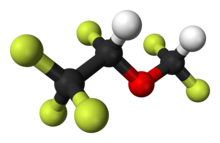Desflurane
 | |
 | |
| Clinical data | |
|---|---|
| Pronunciation | des-FLOO-rane |
| Trade names | Suprane |
| AHFS/Drugs.com | Micromedex Detailed Consumer Information |
| License data |
|
| Pregnancy category |
|
| Routes of administration | Inhalation |
| ATC code | |
| Legal status | |
| Legal status | |
| Pharmacokinetic data | |
| Metabolism | Not metabolized |
| Elimination half-life | Elimination dependent on minute ventilation |
| Identifiers | |
| |
JSmol) | |
| |
| |
| | |
Desflurane (1,2,2,2-tetrafluoroethyl difluoromethyl ether) is a
Some drawbacks of desflurane are its low potency, its pungency and its high cost (though at low flow fresh gas rates, the cost difference between desflurane and isoflurane appears to be insignificant[2]). It may cause tachycardia and airway irritability when administered at concentrations greater than 10% by volume. Due to this airway irritability, desflurane is infrequently used to induce anesthesia via inhalation techniques.
Though it vaporizes very readily, it is a liquid at room temperature.
Desflurane, along with enflurane and to a lesser extent isoflurane, has been shown to react with the carbon dioxide absorbent in anesthesia circuits to produce detectable levels of carbon monoxide through degradation of the anesthetic agent. The CO2 absorbent Baralyme, when dried, is most culpable for the production of carbon monoxide from desflurane degradation, although it is also seen with soda lime absorbent as well. Dry conditions in the carbon dioxide absorbent are conducive to this phenomenon, such as those resulting from high fresh gas flows.[3]
Pharmacology
As of 2005[update] the exact mechanism of the action of general anaesthetics
Stereochemistry
Desflurane medications are a racemate of two enantiomers.[12]
| Enantiomeres of desflurane | |
|---|---|
 (R)-Enantiomer |
 (S)-Enantiomer |
Physical properties
| Boiling point : | 23.5 °C or 74.3 °F | (at 1 atm )
| |
| Density : | 1.465 g/cm3 | (at 20 °C) | |
Molecular Weight : |
168 | ||
| Vapor pressure: | 88.5 kPa | 672 mmHg | (at 20 °C) |
| 107 kPa | 804 mmHg | (at 24 °C) | |
Blood:Gas partition coefficient : |
0.42 | ||
| Oil:Gas partition coefficient : | 19 | ||
| MAC : | 6 vol % |
Physiologic effects
Desflurane induces a dose dependent reduction in blood pressure due to reduced systemic vascular resistance. However, rapid increases in desflurane may induce a transient sympathetic response secondary to catecholamine release. Even though it is highly pungent, it is still a bronchodilator. It reduces the ventilatory response to hypoxia and hypercapnia. Like sevoflurane, desflurane vasodilatory properties also cause it to increase intracranial pressure and cerebral blood flow. However, it reduces cerebral metabolic rate. It also promotes muscle relaxation and potentiate neuromuscular blockade at a greater level than sevoflurane. [13]
Contraindications
It is contraindicated for induction of general anesthesia in the non-intubated pediatric population due to the high risk of laryngospasm. It should not be used in patients with known or suspected susceptibility to malignant hyperthermia. It is also contraindicated in patients with elevated intracranial pressure. [13]
Global-warming potential
Desflurane is a
In March 2023, Scotland became the first country to ban its use due to its environmental impact.[18]
References
- ^ Anvisa (31 March 2023). "RDC Nº 784 - Listas de Substâncias Entorpecentes, Psicotrópicas, Precursoras e Outras sob Controle Especial" [Collegiate Board Resolution No. 784 - Lists of Narcotic, Psychotropic, Precursor, and Other Substances under Special Control] (in Brazilian Portuguese). Diário Oficial da União (published 4 April 2023). Archived from the original on 3 August 2023. Retrieved 16 August 2023.
- ^ Varkey JK (October 2012). Cost Analysis of Desflurane and Sevoflurane: An Integrative Review and Implementation Project Introducing the Volatile Anesthetic Cost Calculator (Doctor of Nursing Practice thesis). Texas Christian University.
- S2CID 41150462.
- ^ Perkins B (7 February 2005). "How does anesthesia work?". Scientific American. Retrieved 30 June 2016.
- ISBN 0-323-03707-0.
- ISBN 978-0-323-28011-2.
- S2CID 72907404.
- ISBN 978-0-323-18654-4.
- ISBN 978-1-4698-3027-8.
- ISBN 978-1-4377-2792-0.
- ISBN 978-1-107-68130-9.
- ISBN 978-3-946057-10-9, S. 175.
- ^ PMID 30725791.
- S2CID 20737354. Retrieved 9 September 2011.
- S2CID 207134715.
- PMID 20935004.
- ^ Sherman JD, Schonberger RB, Eckelman M (October 2014). Estimate of Carbon Dioxide Equivalents of Inhaled Anesthetics in the United States. Proceedings of the American Society of Anesthesiologists Annual Meeting. American Society of Anesthesiologists. New Orleans, LA: American Society of Anesthesiologists. Abstrat A3196. Retrieved 3 June 2015.[dead link]
- ^ "Scotland first to ban environmentally harmful anaesthetic". BBC News. 3 March 2023. Archived from the original on 3 March 2023. Retrieved 3 March 2023.
Further reading
- Eger EI, Eisenkraft JB, Weiskopf RB (2003). The Pharmacology of Inhaled Anesthetics. New Providence.
- Rang HP, Dale MM, Ritter JM, Moore PK (2003). Pharmacology (5th ed.). Edinburgh: Churchill Livingstone. ISBN 978-0-443-07145-4.
- Bellgard M (2005). Evaluation der Sedierungstiefe und der Aufwachzeiten frisch operierter Patienten mit neurophysiologischem Monitoring im Rahmen der Studie: Desfluran versus Propofol zur Sedierung beatmeter Patienten [Evaluation of the depth of sedation and recovery times of newly operated patients with neurophysiological monitoring as part of the study: desflurane versus propofol for sedation of ventilated patients.] (PDF) (Ph.D. thesis) (in German). Bochum. Archived from the original (PDF) on 22 May 2011.
- Lohmann S (2006). Verträglichkeit, Nebenwirkungen und Hämodynamik der inhalativen Sedierung mit Desfluran im Rahmen der Studie: Desfluran versus Propofol zur Sedierung beatmeter Patienten [Tolerability, side effects and hemodynamics of inhaled sedation with desflurane in the context of the study: desflurane versus propofol for sedation of mechanically ventilated patients.] (PDF) (Ph.D. thesis) (in German). Bochum. Archived from the original (PDF) on 4 March 2016.)
- Patel SS, Goa KL (October 1995). "Desflurane. A review of its pharmacodynamic and pharmacokinetic properties and its efficacy in general anaesthesia". Drugs. 50 (4): 742–767. S2CID 249867129.
